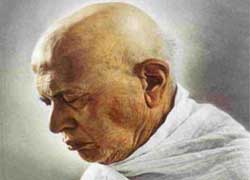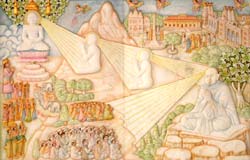Narendra Shah reviews the life and message of a monk who has had a major impact on the twentieth century Jain history of Gujarat.
Early Years
 The
Jain Samaj has been generally interpreted as an orthodox society,
but it is not true. It has witnessed internal movements, a process
of reforms and a strong undercurrent of sensible liberalism which
have given it new directions time and again. Among these, the most
successful twentieth century Jain movement has been spearheaded
by Gurudev Shri Kanji Swami. Gurudev was instrumental in starting
a new revolution in the percept and practice of Jainism, thereby
putting thousands of souls on the true path of salvation.
The
Jain Samaj has been generally interpreted as an orthodox society,
but it is not true. It has witnessed internal movements, a process
of reforms and a strong undercurrent of sensible liberalism which
have given it new directions time and again. Among these, the most
successful twentieth century Jain movement has been spearheaded
by Gurudev Shri Kanji Swami. Gurudev was instrumental in starting
a new revolution in the percept and practice of Jainism, thereby
putting thousands of souls on the true path of salvation.
Kanji Swami was born in Umrala, a small village in the Kathiawar region of
Gujarat, in V.S. 1946 (1889 AD) to a Sthanakvaasi family. He showed a great
ability for learning and was considered the most intelligent student of his
class in the school. His mother died when he was 13 and he lost his father
at the age of 17. After this, he started looking after his father's shop. He
utilised the frequent periods of lull in the shop in reading various books
on religion and spirituality. Turning down the proposals of marriage, he confided
in his brother that he wanted to remain celibate and take up renunciation.
Renunciation
 Eventually
he took renunciation as a Sthanakvaasi monk in 1914 at the hands
of Shri Hirachandji Maharaj. During the ceremony, while riding
on an elephant, he inauspiciously tore his robe, which was later
to prove an ill omen in his monastic career. He embarked upon a
rigorous study of the Shwetamber scriptures and finished a detailed
study of the 45 Agams (Jain Scriptures) including a deep analysis
of several hundred verses. Being a believer in purushaarth (self
effort) for achieving emancipation, he quickly became a learned
and famous monk and, backed by his seventeen renditions of the
Bhagvati Sutra with its 100,000 verses, came to be known as the
'Kohinoor of Kathiawar.'
Eventually
he took renunciation as a Sthanakvaasi monk in 1914 at the hands
of Shri Hirachandji Maharaj. During the ceremony, while riding
on an elephant, he inauspiciously tore his robe, which was later
to prove an ill omen in his monastic career. He embarked upon a
rigorous study of the Shwetamber scriptures and finished a detailed
study of the 45 Agams (Jain Scriptures) including a deep analysis
of several hundred verses. Being a believer in purushaarth (self
effort) for achieving emancipation, he quickly became a learned
and famous monk and, backed by his seventeen renditions of the
Bhagvati Sutra with its 100,000 verses, came to be known as the
'Kohinoor of Kathiawar.'
But all this time he could never completely engage with the scriptures
he was studying and continued his search for the still evasive
Truth. Then, around 1921, he came upon Acharya KundKund's Samaysaar
- 'Essence of the Doctrine' - the study of which was like "drinking the nectar of Truth" for
him. He followed on by studying the writings of other Digambers
such as Acharyakalp Pandit Todermalji and Shrimad Rajchandra.
During his discourses he began to incorporate the ideas picked
from these studies and began to lead a kind of double life, nominally
a Sthanakvasi monk but referring to the Digamber literature.



